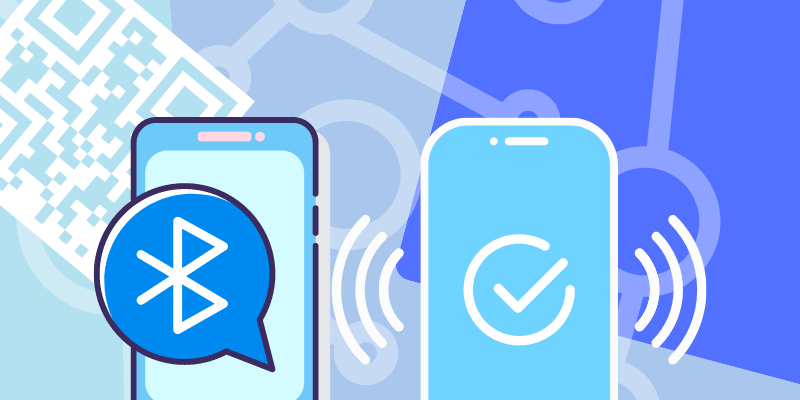
The way we exchange information and connect with each other has evolved significantly. The emergence of digital business cards is a testament not only to the empowerment and sustainability of modern information exchange mediums, but also of their versatility. Digital business cards leverage various technologies, including QR codes, Bluetooth, and NFC (Near Field Communication), to enable seamless information sharing.
QR Codes
Though QR codes have become increasingly popular in the past decade, they are actually a relatively old technology. In 1994, a company known as DENSO WAVE ran a survey across supermarkets and the limitations of barcodes. Masahiro Hara, the company’s lead developer at the time discovered that condensing a barcode into a square shape, and having it be two dimensional (two directions of coding), allowed for faster exchange of information. The company elected to not maintain patent rights, enabling the use of QR codes to spread across the world and industries.
The reason for their popularity is due to their ease of use and compatibility with a wide range of devices. QR stands for Quick Response, and they store data horizontally and vertically, enabling them to hold substantial amounts of information. To read a QR code, you need a scanner app on your smartphone or a built-in QR code reader on newer devices.
Today, this form of exchanging information is widely used for various applications, including digital business cards, product information, and promotional campaigns. Your QR code is the bridge to your digital business card, allowing you to instantly share all of your relevant profiles, website links, and payment platforms to facilitate more efficient and practical networking practices.
Bluetooth
Bluetooth is a wireless technology that allows data transfer between devices over short distances. It operates on the 2.4 GHz frequency and is commonly found in smartphones, tablets, laptops, and other portable devices. Bluetooth-enabled digital cards leverage this technology to establish a connection between devices for information exchange.
To share a digital card using Bluetooth, both devices need to have Bluetooth enabled and be within close proximity. Once the devices are paired, the cardholder can transfer their digital card directly to another device, typically using a dedicated app or the device’s built-in sharing feature. While bluetooth is an easy and highly compatible option, there are also severe risks that come with exchanging information via this method.
One risk includes “Bluesnarfing”, a ruthless cyberattack that steals information from devices. Another risk is that of “Bluebugging”, where cybercriminals acquire access to devices allowing hackers to spy on and gain access to sensitive information. Bluetooth is convenient for sharing digital cards in person, but it requires devices to be within a limited range and may require additional setup steps for pairing.
NFC
NFC digital cards function by tapping or bringing the card close to an NFC-enabled device. The cardholder’s information is then transferred securely and instantly to the recipient’s device. While the technology is widely used for contactless payments, public transportation systems, and access control applications, it is also the go-to method of exchanging information through smart business cards, which is then saved onto the recipient’s address book in their respective device. Its short-range nature makes it ideal for quick and secure information sharing during face-to-face interactions.
It is much more secure than a bluetooth method of transacting information, and can be a great alternative to scanning QR-codes. Rather than having the recipient scan a code, they simply tap your card on their device. The challenges in security with NFC enabled devices is that someone may tap their device on yours and receive information and data, however avoiding such an incident is relatively simple: keep it in a wallet or a sleeve of its own.
Differences and Applications of Digital Business Card Technologies
Each of these digital card technologies offers distinct advantages and applications:
- QR codes are widely compatible, easy to generate and scan, and can hold extensive information. They are an excellent medium for sharing information in various scenarios, both online and offline.
- Bluetooth-enabled digital business cards are a convenient option in face-to-face interactions where devices can be paired and information can be transferred wirelessly. However, they come with inherent risks, making NFC embedded cards a better option for in-person meetings.
- NFC digital cards provide quick and secure information sharing by tapping or bringing the card close to an NFC-enabled device.
QR codes, Bluetooth, and NFC are three distinct digital card technologies that enable seamless information sharing in our increasingly digital world. Understanding their differences and applications allows us to make informed decisions about which technology best suits our needs. For instance, QR codes are excellent for widespread distribution and compatibility, Bluetooth works well for face-to-face interactions, however it comes with an extent of risks, and NFC is ideal for quick and secure exchanges in-person. The choice between the three options ultimately depends on factors such as compatibility, convenience, and the context of use.
At Covve, we offer smart business cards that are both NFC embedded and equipped with QR codes, and are paired with your digital business card that can be shared with a QR code via your smartphone, tablet, and even in the background of your online meetings.
Create your own digital business card today with Covve – ready to share in a single tap or scan.
Updated on 13 Jul 2023.
Related Posts: